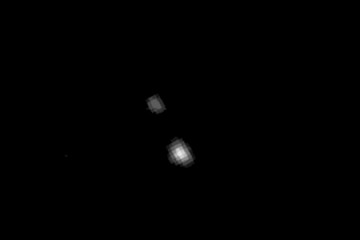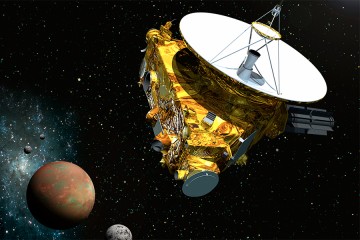NASA's New Horizons mission has returned to normal operations and remains on schedule for its flyby of Pluto next week after an operational anomaly over the weekend briefly caused scientists to lose contact with the distant spacecraft.
On Saturday, just before 2 p.m. EDT, the mission operations center at the Johns Hopkins University Applied Physics Laboratory lost contact with the unmanned craft. During that time, the autonomous autopilot on board the spacecraft recognized a problem and—as it's programmed to do in such a situation—switched from the main to the backup computer. The autopilot placed the spacecraft in "safe mode" and commanded the backup computer to reinitiate communication with Earth.
New Horizons then began to transmit telemetry to help engineers diagnose the problem. Communications was reestablished at 3:15 p.m. EDT.
An investigation concluded that no hardware or software fault occurred on the spacecraft. The underlying cause of the incident was a hard-to-detect timing flaw in the spacecraft command sequence that occurred during an operation to prepare for its flyby of Pluto on July 14. No similar operations are planned for the remainder of the Pluto encounter.
"I'm pleased that our mission team quickly identified the problem and assured the health of the spacecraft," said Jim Green, NASA's Director of Planetary Science. "Now, with Pluto in our sights, we're on the verge of returning to normal operations and going for the gold."
Preparations are ongoing to resume the originally planned science operations by Tuesday and to conduct the entire close flyby sequence as planned. The mission science team and principal investigator have concluded that the science observations lost during the anomaly recovery do not affect any primary objectives of the mission, with a minimal effect on lesser objectives.
"In terms of science, it won't change an A-plus even into an A," said Alan Stern of the Southwest Research Institute in Boulder, Colorado, principal investigator for the New Horizons mission.
Adding to the challenge of recovery is the spacecraft's extreme distance from Earth. New Horizons is almost three billion miles away, where radio signals, even traveling at light speed, need four and a half hours to reach Earth. Two-way communication between the spacecraft and its operators requires a nine-hour round trip.
New Horizons, which is closing in on Pluto at about 31,000 miles per hour, has already covered nearly than three billion miles since its launch on Jan. 19, 2006. Its epic journey has taken it past each planet's orbit, from Mars to Neptune, in record time, and it is now days away from its long-awaited encounter with the dwarf planet Pluto, the most distant planet in our solar system.
Posted in Science+Technology
Tagged applied physics laboratory, space exploration, nasa, new horizons









